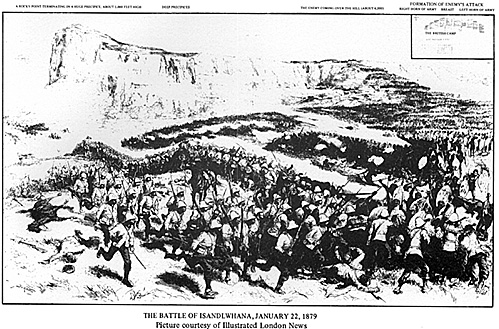NO MORE ISANDLWHANA'S
With around 6,000 Zulu warriors dead, most of the military kraals destroyed along with hundreds of civilians homesteads, the whole Zulu way of life had been shattered by the war.
The king himself was captured by a patrol on the 28th August and was exiled to Cape Town where he was well treated. As for Zululand, the British withdrew. The idea of bringing the country into the Confederation was abandoned. It was split into 13 small kingdoms, each one being ruled over by various chiefs who had shown allegiance to the British or at least had no love for the king.
Once all the British troops had withdrawn, fighting broke out as the larger factions started to attack the smaller supporters of the old King, seeking revenge whilst nobody watched. Appeals were sent to Britain for Cheshwayo to be reinstated, he himself had been pressing to be granted permission to go back to Zululand.
In September 1881, the King was ordered to Britain, to state his case, where he met with Queen Victoria and was an instant success with her and the British people. This led to the granting to Cheshwayo of his wish to go back to his homeland, no doubt in the hope that he could calm things down as Zululand was in a state of virtual civil war.
In January 1883, he set foot back on his soil once more, he was given a small kingdom to rule over where he built another homestead at Ulundi and even raised some new regiments, although they had to be used purely for ceremonial events only. With infighting still taking place and the King unable to intervene due to British restrictions on him, there took place a battle between the Kings supporters and the major opposing faction led by Zibhebhu a once loyal inDuna, during the war but now no friend of the King. The Usuthu warriors of the King were ambushed and slaughtered, with as many as 4,000 being killed. In July 1883, Zibhebhu was marching on Ulundi with an Impi and almost succeeded in killing the King, who just managed to escape.
With all order lost, the once proud King made for the British Magistracy at Eshone, asking for help to try to restore order and help his supporters. It was here he was to die, on the 8th February 1884.
It is here we leave the Zulu story. We shall return on a later date to Zululand as the events after the Kings death are no less fascinating and offer the wargamer plenty of possible scenarios for the player who is just a little bit fed up with re-fighting Isandlwana for the sixteenth time.
THE BATTLE OF ISANDLWHANA,
JANUARY 22, 1879

Back to Colonial Conquest Issue 3 Table of Contents
Back to Colonial Conquest List of Issues
Back to MagWeb Master List of Magazines
© Copyright 1993 by Partizan Press.
This article appears in MagWeb (Magazine Web) on the Internet World Wide Web.
Other military history articles and gaming articles are available at http://www.magweb.com